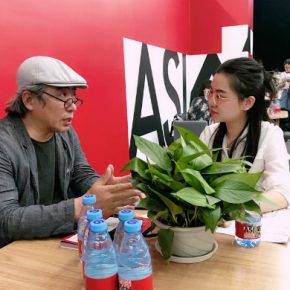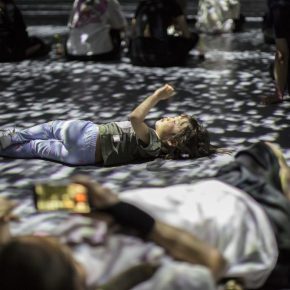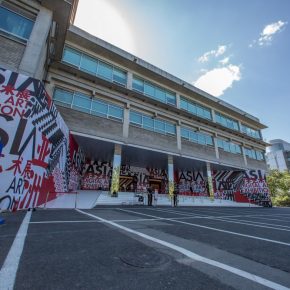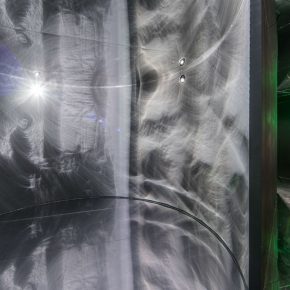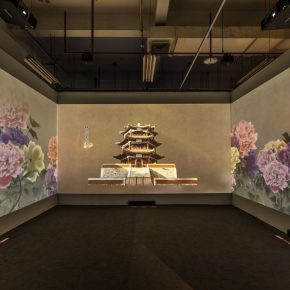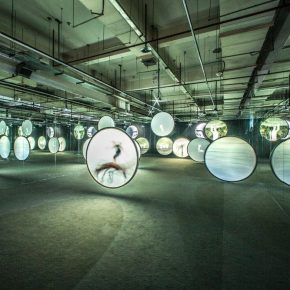
The “Asian Digital Art Exhibition” is the first large-scale art exhibition themed on “Asia” in the field of digital art. The digital art works by 30 artists from 12 countries and regions are featured. This exhibition is also a stage for the dialogue between art and science. With a variety of different techniques and artistic means as carriers and mediums, artists discuss the profound issues of humanity, technology and the future.
CAFA ART INFO specially invited Professor Song Xiewei, Chief Curator of the Asian Digital Art Exhibition and the Dean of the School of Design of the Central Academy of Fine Arts, to conduct an exclusive interview. From his personal experience, he first of all shared his interpretation on the theme of this exhibition, which provided a perspective to understand digital art, and as an educator, he also expounded the new discipline of “Art and Technology” and the topic of “Design as a New Way of Life”. The most inspiring and forward-looking ideas he introduced will provide a new thinking opportunity for us to understand the present and the future phenomenon of design.
Interviewed Guest: Song Xiewei (General Curator of the Asian Digital Art Exhibition, Dean of the School of Design, Central Academy of Fine Arts)
Interviewer: Zhang Yizhi (CAFA ART INFO)
CAFA ART INFO: First of all, congratulations on the success of the “Asian Digital Art Exhibition”. According to our understanding, this exhibition is based on the presentation of integrated beauty. As the chief curator of this exhibition, how do you understand and interpret the key word “integration”?
Professor Song: Well, first of all, we usually understand “integration” from the perspective of physics, which is about the relationship among different types of materials. The “integration” we present here refers to civilizations within Asia and the integration of Asia and diverse civilizations of the world; the integration of Asian culture and digital technology in the context of globalization. In the Asian Digital Art Exhibition, research on robots, AI research, game research, and video research which are not entirely based on software development or the technological research of digital art, but based on intervention and research with technological means on future values of human economic development and future human survival which is an inevitable way to construct the future social city.
CAFA ART INFO: As you just mentioned, these are hot topics for “building the future society and studying new lifestyles”. A large number of exhibitions and activities have presented fresh trends. From your point of view, how would you further interpret the emergence, development and future trends of this phenomenon?
Professor Song: Actually, this matter is very simple. It has been restored to the life we are confronted with, and in more detail, they are items that relate to life. If looking forward, we are concerned that the world has undergone changes. For example, China has proposed “The Belt and Road”, “Conference on Dialogue of Asian Civilizations” and other major events in society, including recent Sino-US trade wars that reflect the changes in international scene and strategy. From a historical point of view, dramatic changes take place every century. For example, the United States seized the historical wave of the second industrial revolution and the third scientific and technological revolution and was in the forefront of the world, which comprehensively demonstrated that science and technology are the primary productive forces. At present, the whole world is experiencing a turning point from the third industrial revolution to the fourth industrial revolution. From the perspective of the global development potential, energy and technology, China’s developing speed and scale are rare throughout the world and we should also export according to the Chinese system.
So what is the Chinese way? The West intends to impose their values on China, but we do not follow the same path. We just propose economic or cultural development models. For us, the core of the epochal changes is that the core structure of productivity has changed and the core structure of the products has changed. For example, if Apple produces cars, it is not going to grab the business of the original car companies. What is a car? During the industrial revolution, the automobile was developed from parallel moving objects with engines supported by gasoline. It can be called automobile products, or industrial design and product design. This is the life product brought by the industrial revolution. And today’s car products shape the future car products that have begun to become unmanned, where does the power come from? It is an interactive system, and the interactive system is the core of Apple. Taking a mobile phone as an example, it is not physics, but digital. The production model of the industrial revolution has turned to the model of the digital age, so unmanned technology is equivalent to providing us with a reinterpretation of values. Its return on profit is not based on physical products, but on the return of big data. The application of the future group system forms the big data and big data forms the return of value. This is my personal interpretation.
CAFA ART INFO: As the Dean of the School of Design, you have also held a variety of activities on the future design research, such as the “Future Unknown” and “Biennial of Moving Image”, etc., the teaching structure in the School has also been adjusted accordingly, can you go deeper into the basic thinking path of making initiatives in this regard?
Professor Song: We have long recognized the changes that have taken place in the world. Therefore, the School of Design has made various efforts in the development of design discipline and teaching reforms in recent years in response to global technological, social and industrial changes. This proposition for the undergraduate degree show this year is created by reading Brief History of Humankind, A Brief History of Tomorrow, 21 Lessons for the 21st Century, based on the contents of the three books, and a thorough systematic understanding, analysis, research, and re-engineering from the perspective of the developer. Although the evaluation of the three books which is complicated from the perspective of scholars, in any case, these three brief historical perspectives provide us with a study of history and an imagining of the future. Any subject can find a topic related to its development. Therefore, from our events to today's Asian Digital Art Exhibition, as well as the 2018 “POST-LIFE Beijing Media Art Biennale” and the 2016 “Ethics of Technology” Beijing Media Art Biennale, their themes were chosen based on our sensitive feedback to global events. For example, the first “Ethics of Technology” Beijing Media Art Biennale, curated ideas that stemmed from “Li Shishi’s Go Wars against Alpha Dogs” and the background related to this event — people involved in the development of robots are concerned with ethical issues — in the future, will people control machines or machines control people?
The reforms and developments of the design discipline are all based on the macroscopic pattern and thinking from the perspective of human development, rather than thinking about it as the basis of the current industry. Today, the School of Design, Central Academy of Fine Arts with its responsibilities and ideals, has done a lot of research with the same attitude as Chinese design educators. As a first-class discipline of the Ministry of Education, we have established a new “big design” education pattern by setting up five modules of “design strategy, technology design, design thinking, industrial design, design theory” to lead towards the innovative development of Chinese design education.
During the period of 2017-2018, we launched the “Future Unknown – Global Education Plan”, from the first stage “Compulsive Innovation” to the second stage “Youth Expressed”, the third stage “Education Absence” and so on to conduct explorations in future art design education.
The first section, through the network platform, is based on the theme of education that influences this epoch. We collect 100 hot issues related to current educational trends and provide on-the-spot discussion topics for round-table dialogue guests. The guests who participated in the forum and responded were masters who have influenced and changed this era, such as Kevin Kell, Bruce Mau and so on. The second section will conduct in-depth research and cooperation by inviting institutions (Chinese Academy of Art, Tsinghua University, Sichuan Fine Arts Institute, LuXun Academy of Fine Arts, etc.) that raise relevant issues in “Compulsive Innovation”, with the research workshops of educators and students as the main body, through six months of educational practice, the teaching process and phased results will be presented in the form of literature. The third edition of “Teaching and Education for the Future” is based on educational leaders and strategists, we invite principals, deans, education experts and scholars from well-known universities around the world to continue to explore the future of design education through five sub-themes. They share their thoughts on future art design education, showcase global education leadership, and jointly build a new model of future art design education. Finally, the Principal of the Royal College of Art and I have jointly launched a global design education community that brings together experts, smart collisions, multiple voices, and win-win cooperation.
CAFA ART INFO: Through the reflection and response of 30 international artists to their own cultural traditions by digital media, the exhibition presents the integration of the seemingly different digital art behind the complexities of Asia in the context of geography and globalization. In your opinion, what is the relationship between Asia and the world? What is a characteristic of being the fastest growing area?
Professor Song: First of all, I want to elaborate on the source of this exhibition. As one of a series of activities of the “Conference on Dialogue of Asian Civilizations”, we must make a voice from the perspective of “dialogue”. Why do we want to talk about civilized dialogue? Asia has nurtured many ancient civilizations, and the cultural traditions have been affected for thousands of years. At the same time, Asia is one of the fastest developing and most dynamic regions in the world, especially China’s rapid development which has a huge impact on the world. In this context, we invite Asian artists (but not limited to Asian artists) to engage in the dialogue and outlook of digital, technology and art in Asia and the world from a more diversified perspective. At the same time, we have tried to create a stage of dialogue between art and technology, with a variety of technologies and artistic means as a carrier and medium to jointly explore the profound issues of humanity, technology and the future.
CAFA ART INFO: The Asia Digital Art Exhibition is a stage for dialogue between art and technology. Artists from different cultural contexts and academic backgrounds in Asia meet here, and they exchange ideas and discuss how to activate innovation. What is the selection criteria for artists?
Professor Song: In the selection process of the works, we first invited the influential artists in the digital art field to construct the first section of the exhibition, “The Themed Exhibition.” The second section of the “Culture +Technology Exhibition” focuses on the achievements of a number of research projects related to culture, science and technology, exploring the new scenes combined culture, innovation with science. They include the latest interdisciplinary experimental projects, digital interpretation projects for cultural heritage. The exhibition platform will unite with China’s leading technology companies to create a digital and cultural industry with its innovative technology. The third section of the “Audio Visual Art Exhibition” invites young and international audiovisual artists to create immersive digital works and the most futuristic concept of space, and to form an experiment on the future art form while upgrading the interactive experience of the exhibition and forming experimental discussions on future forms of art.
As a curator, I believe this exhibition will provide you with an idea of how digital art will expand into the future and how digital art can present the traditional culture of Asia. For example, the German artist Tobias Gremmler, who lives and works in Hong Kong, his works “Chinese Calligraphy in Motion”, “Virtual Actors in Chinese Opera”, “Kung Fu Motion Visualization” revolve around Chinese characters, Peking Opera and Kung Fu and other elements, constitute a new interpretation and presentation of Chinese traditional culture in the form of digital art. Under the theme of the Conference on Dialogue of Asian Civilizations “focusing on the exchange of mutual understanding and destiny in Asian civilization”, many works in the exhibition reflect the influence of Chinese civilization genes on Asia and even on international art trends.
I think that the presentation of art and technology is not limited to digital media. It also includes other new high-tech technologies, not only computer-generated technologies, but also virtual technologies such as artificial intelligence, big data, VR, and AR. I suggest that artists can use more emerging technologies in future creations to collaborate with scientists and engineers. Art and technology are just like the game between the human brain and AI. In the intensified intervention, they breed and stimulate a mutual development process.
CAFA ART INFO: Thank you.
Translated and edited by Sue/CAFA ART INFO
Photo Courtesy of the Organizer


